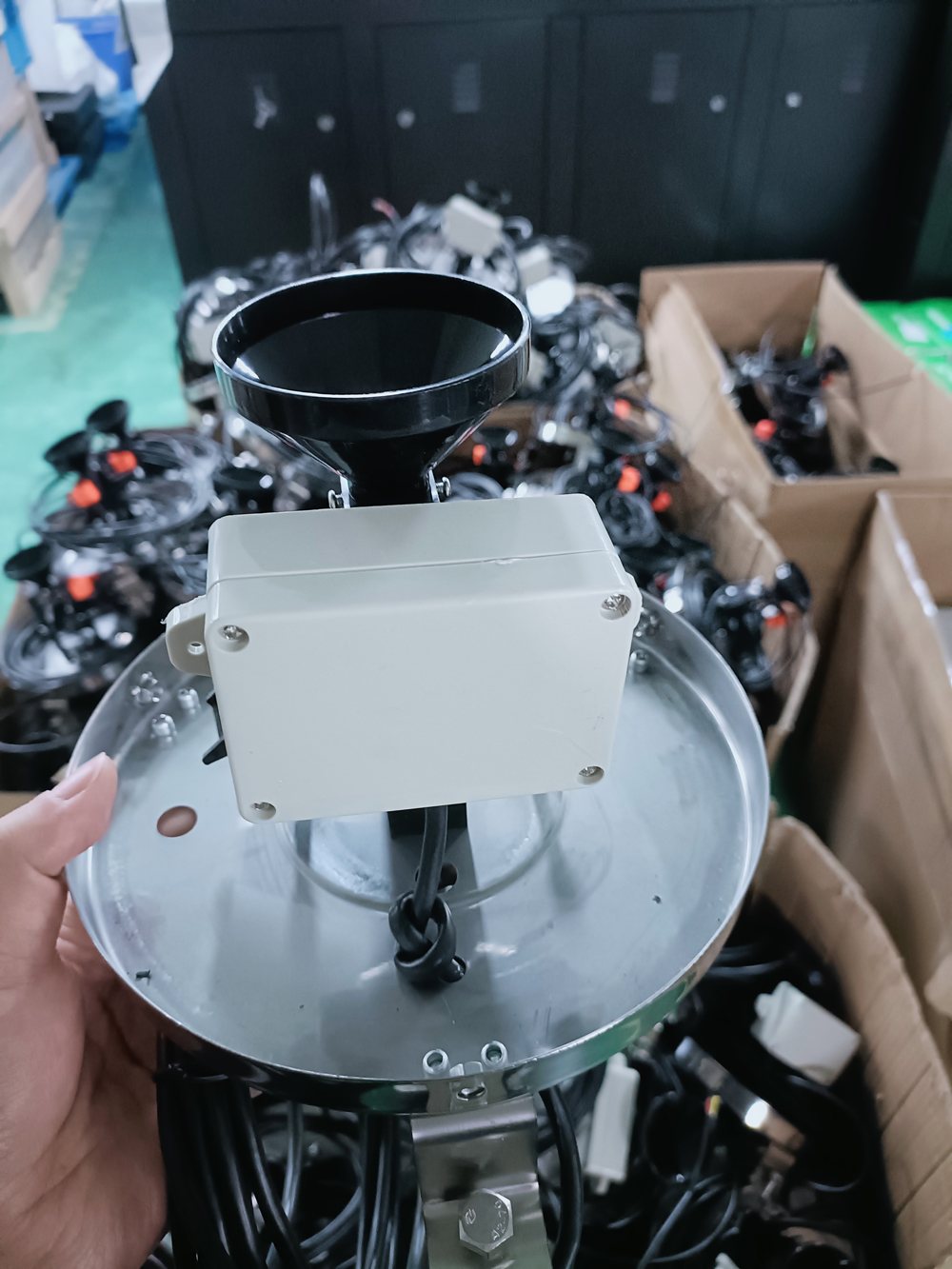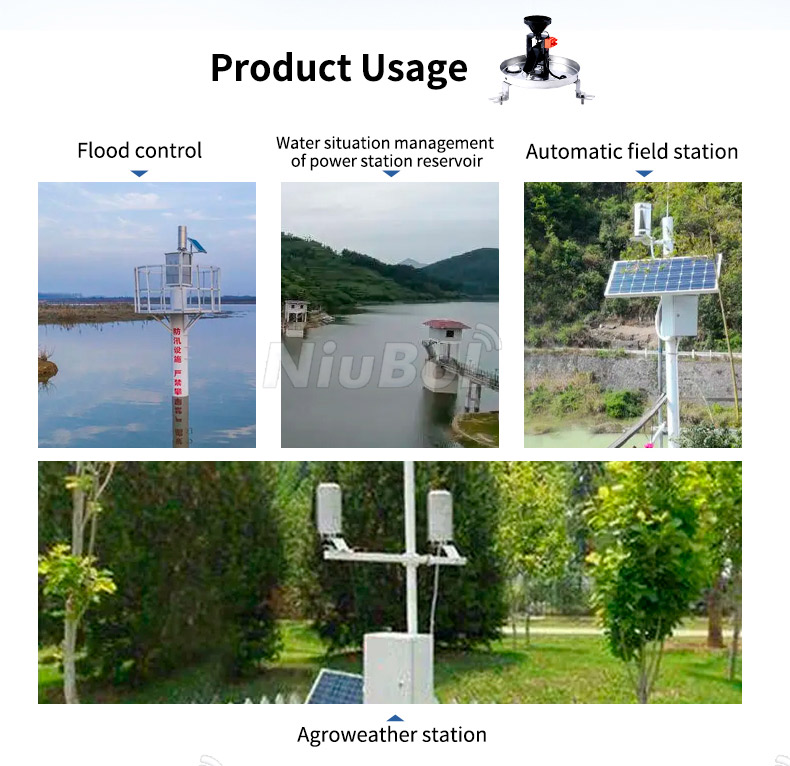

— Blogs —
—Products—
 Consumer hotline +8618073152920
Consumer hotline +8618073152920 WhatsApp:+8615367865107
Address:Room 102, District D, Houhu Industrial Park, Yuelu District, Changsha City, Hunan Province, China
Product knowledge
Time:2024-08-13 22:13:30 Popularity:1467
In a weather station, rain gauges are usually deployed as part of an Automatic Weather Station (AWS). AWS can automatically collect, process and transmit data of various weather elements, including rainfall, for real-time monitoring and remote transmission of weather data. Rain Gauge, as an important component, can accurately record the changes in precipitation during the rainfall process, providing an important basis for weather forecasting and scientific research.
Rain Gauge is an important equipment for measuring rainfall in weather stations. It can accurately record and analyse precipitation data, providing key information for weather forecasting, water resource management, agricultural irrigation and other fields. In weather stations, rain gauge is usually used in conjunction with other meteorological instruments such as wind speed and direction meter, temperature and humidity recorder, etc., which together constitute a complete meteorological observation system.
Rain gauge is used to measure the amount of precipitation over a period of time, different types of rain gauges have different working principles. The following is the working principle of the tipping bucket rain gauge and piezoelectric rain gauge:
The tipping bucket rain gauge is a common mechanical rainfall measurement instrument, and its working principle is as follows:
1. Structure: The tipping bucket rain gauge is mainly composed of a collector, a tipping bucket, a counter and a data processing device. The collector is usually a funnel-shaped structure to receive precipitation.
2. working process:
- When rainwater flows into the tipping bucket through the collector, the amount of water in the tipping bucket increases gradually.
- When the volume of water in the hopper reaches a certain amount (usually a fixed small amount, such as 0.2 mm of precipitation), due to the effect of gravity, the hopper will flip to the other side, and at the same time, the water will be discharged.
- Each flip of the tipping bucket is recorded by a mechanical or electronic counter.
- After the tipping bucket is reset, precipitation can continue to be collected and the process repeated.
3. Data processing: The counter records can be converted to precipitation data by a data processing unit. Usually, each turn of the tipping bucket represents a certain amount of precipitation, and the total amount of precipitation can be calculated from the counter readings.
Piezoelectric rain gauge is a kind of instrument that uses piezoelectric effect to measure precipitation, and its working principle is as follows:
1. Structure: The piezoelectric rain gauge is mainly composed of a piezoelectric sensor, a collector and an electronic signal processor. The piezoelectric sensor is usually located below the collector.
2. Working process:
- When precipitation (e.g. raindrops) falls on the collector, the impact force of the raindrops is transmitted to the piezoelectric sensor.
- The piezoelectric sensor has one or more layers of piezoelectric material inside, which generates an electric charge on its surface when a force is applied.
- The amount of charge generated is proportional to the impact force of the raindrops and is therefore related to the size and velocity of the raindrops.

3. Signal processing:
- The generated charge signal is amplified and filtered by an electronic signal processor.
- The processor can calculate the intensity and total amount of precipitation based on the intensity and time interval of the charge signal.
The advantage of the piezoelectric rain gauge is that it can provide highly accurate precipitation data and differentiate between different sizes of raindrops, making it suitable for scientific research and high-precision precipitation monitoring. However, it requires higher maintenance and calibration and usually costs more than tipping bucket rain gauges.
1.Piezoelectric rain gauge: It is a high-precision device used in meteorological stations to measure rainfall. It adopts piezoelectric ceramic kinetic energy type rainfall monitoring technology, through the measurement of the energy of the raindrop impact to identify the rainfall, with simple installation, accurate data, monitoring range and other advantages. Piezoelectric rain gauge is widely used in meteorological and environmental monitoring, hydrological and hydraulic comprehensive monitoring station, traffic and road monitoring, agricultural and forestry irrigation, wind power generation and other fields, providing key data support for meteorological forecasting, water resource management, agricultural irrigation and so on.
1.1 High precision: using ultrasonic technology to ensure the accuracy and reliability of the measurement results.
1.2 Rapid response: it can quickly capture the beginning and end of precipitation and reduce data delay.
1.2 Environmental adaptability: not affected by water quality, impurities and other external factors, suitable for measurement under various environmental conditions.
records rainfall by the number of times the tipping bucket is turned over, suitable for long-term, continuous rainfall monitoring. The number of times the bucket is turned over is directly proportional to the amount of rainfall, so the amount of rainfall can be obtained by counting the number of times the bucket is turned over.
2.1. Highly accurate measurement: Adopting precision tipping bucket design, it provides three resolution options of 0.2mm, 0.5mm and 0.1mm, which ensures that every precipitation from drizzle to rainstorm can be recorded accurately and meets the needs of different users for data accuracy.
2.2 Durable materials: The main structure is made of high-quality materials, such as stainless steel or weather-resistant plastic, to ensure that long-term outdoor use is not affected by the environment, which is especially suitable for stable operation under extreme weather conditions.
2.3 Easy installation and compatibility: Standardised interface design, easy installation, seamless connection with most weather software and hardware platforms, enhancing the overall flexibility of the system.

1. Weather forecasting
Precipitation is one of the important parameters for weather forecasting. The rain gauge can monitor precipitation in real time and provide accurate precipitation data for weather forecasters, which helps to improve the accuracy of weather forecasting.
2.Water Resource Management
The precipitation data monitored by the rain gauge is of great significance for water resource management. By analysing the precipitation data, it can provide scientific basis for reservoir scheduling and water resource allocation.
3.Disaster Early Warning
Rain gauge has an important role in monitoring extreme weather events. When the precipitation exceeds a certain threshold, it can issue timely warnings for disasters such as rainstorms and floods, winning valuable time for disaster prevention and mitigation.
4. Agricultural production
Precipitation has an important impact on agricultural production. Through the rain gauge monitoring data, it can provide reference for farmland irrigation, crop growth, etc., to help agricultural production.
In addition, rain gauge is also widely used in agricultural irrigation and other fields. Through the accurate monitoring and analysis of rainfall, it can formulate reasonable water use plans, predict the risk of flooding, optimise agricultural irrigation strategies, etc., so as to achieve the rational use of water resources and effective prevention and control of disasters.
Summary
Rain gauge is one of the indispensable and important equipments in meteorological stations, which provides key information for meteorological forecasting, water resource management, agricultural irrigation and other fields through accurate measurement of rainfall data. With the continuous development and progress of science and technology, the measurement accuracy and stability of the rain gauge will continue to improve, and its application in meteorological observation and scientific research will be more extensive and in-depth.
NBL-W-RS-Tipping-bucket-rain-gauge-instruction-manual-0.5mm.pdf
NBL-W-ARS-Tipping-bucket-rain-gauge-instruction-manual.pdf
NBL-W-RS-Rain-sensors-instruction-manual-V4.0.pdf
Related recommendations
Sensors & Weather Stations Catalog
Agriculture Sensors and Weather Stations Catalog-NiuBoL.pdf
Weather Stations Catalog-NiuBoL.pdf
Related products
 Combined air temperature and relative humidity sensor
Combined air temperature and relative humidity sensor Soil Moisture Temperature sensor for irrigation
Soil Moisture Temperature sensor for irrigation Soil pH sensor RS485 soil Testing instrument soil ph meter for agriculture
Soil pH sensor RS485 soil Testing instrument soil ph meter for agriculture Wind Speed sensor Output Modbus/RS485/Analog/0-5V/4-20mA
Wind Speed sensor Output Modbus/RS485/Analog/0-5V/4-20mA Tipping bucket rain gauge for weather monitoring auto rainfall sensor RS485/Outdoor/stainless steel
Tipping bucket rain gauge for weather monitoring auto rainfall sensor RS485/Outdoor/stainless steel Pyranometer Solar Radiation Sensor 4-20mA/RS485
Pyranometer Solar Radiation Sensor 4-20mA/RS485
Screenshot, WhatsApp to identify the QR code
WhatsApp number:+8615367865107
(Click on WhatsApp to copy and add friends)
